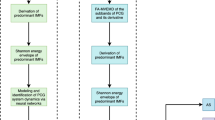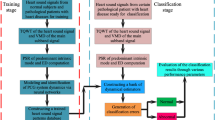Abstract
Phonocardiogram based auscultation is the most suitable cardiac examination technique for primary health care since heart sound can be captured and analyzed using a smart-phone and a digital stethoscope. The phonocardiogram signal provides, among others, valuable information about valve functioning of the heart. It is well known that many heart problems are associated with valve dysfunctions. Notably, the time differences between valves closure are very critical to diagnose some pathologies. Hence, the need of the correct detection of these instants. Up to now, this research problem represents a serious challenge. This Study takes place in this area of concern and targets to propose a greedy-based two-stage strategy to detect the instants of the heart valves closure. The first stage concerns the dictionary construction from the estimation of the impulse response functions associated to each heart valve. In the second stage, the instants of valves closures are identified by applying the Orthogonal Matching Pursuit algorithm alongside the constructed dictionaries. Simulations on both synthetic and real-life phonocardiogram signals are performed to validate the performance of the proposed two-stage approach in detecting the closure instants of the heart valves.













Similar content being viewed by others
References
Pham, D. H., Meignen, S., Dia, N., Fontecave-Jallon, J., & Rivet, B. (2018). Phonocardiogram signal denoising based on nonnegative matrix factorization and adaptive contour representation computation. IEEE Signal Processing Letters, 25(10), 1475–1479.
Liu, C., Springer, D., Li, Q., Moody, B., Juan, R. A., Chorro, F. J., et al. (2016). An open access database for the evaluation of heart sound algorithms. Physiological Measurement, 37(12), 2181–2213.
Choklati, A., Sabri, K., & Lahlimi, M. (2017). Cyclic analysis of phonocardiogram signals. International Journal of Image, Graphics and Signal Processing, 9(10), 1–11.
Choklati, A., & Sabri, K. (2018). Cyclic analysis of extra heart sounds: Gauss kernel based model. International Journal of Image, Graphics and Signal Processing, 10(5), 1–14.
Addison, P. S. (2017). The illustrated wavelet transform handbook: Introductory theory and applications in science, engineering, medicine and finance (Second ed.). Boca Raton: CRC Press.
Meziani, F., Debbal, S. M., & Atbi, A. (2012). Analysis of phonocardiogram signals using wavelet transform. Journal of Medical Engineering and Technology, 36(6), 283–302.
Huiying, L., Sakari, L., & Iiro, H. (1997). A heart sound segmentation algorithm using wavelet decomposition and reconstruction. In (Vol. 4, No. 1, pp. 1630–1633).
Wang, W., Guo, Z., Yang, J., Zhang, Y., Durand, L. G., & Loew, M. (2001). Analysis of the first heart sound using the matching pursuit method. Medical and Biological Engineering and Computing, 39(6), 644–648.
Nieblas, C. I., Alonso, M. A., Conte, R., & Villarreal, S. (2013). High performance heart sound segmentation algorithm based on matching pursuit. In 2013 IEEE digital signal processing and signal processing education meeting (DSP/SPE). IEEE.
Choi, S., & Jiang, Z. (2008). Comparison of envelope extraction algorithms for cardiac sound signal segmentation. Expert Systems with Applications, 34(2), 1056–1069.
Tseng, Y. L., Ko, P. Y., & Jaw, F. S. (2012). Detection of the third and fourth heart sounds using Hilbert–Huang transform. BioMedical Engineering OnLine, 11(1), 1–8.
Taralunga, D. D., & Neagu, G. M. (2018). In IFMBE proceedings (pp. 387–391). Singapore: Springer.
Sun, H., Chen, W., & Gong, J. (2013). An improved empirical mode decomposition-wavelet algorithm for phonocardiogram signal denoising and its application in the first and second heart sound extraction. In 2013 6th international conference on biomedical engineering and informatics. IEEE.
Wu, Z., & Huang, N. E. (2009). Ensemble empirical mode decomposition: A noise-assisted data analysis method. Advances in Adaptive Data Analysis, 01(01), 1–41.
Papadaniil, C. D., & Hadjileontiadis, L. J. (2014). Efficient heart sound segmentation and extraction using ensemble empirical mode decomposition and kurtosis features. IEEE Journal of Biomedical and Health Informatics, 18(4), 1138–1152.
Nigam, V., & Priemer, R. (2006). A dynamic method to estimate the time split between the a2 and p2 components of the s2 heart sound. Physiological Measurement, 27(7), 553–567.
Sæderup, R. G., Hoang, P., Winther, S., Bøttcher, M., Struijk, J., Schmidt, S., et al. (2018). Estimation of the second heart sound split using windowed sinusoidal models. Biomedical Signal Processing and Control, 44, 229–236.
Comon, P., & Jutten, C. (2010). Handbook of blind source separation: Independent component analysis and applications. Cambridge: Academic press.
Bobin, J., Starck, J. L., Moudden, Y., & Fadili, M. J. (2008). Blind source separation: The sparsity revolution. Advances in Imaging and Electron Physics, 152(1), 221–302.
Ehler, M. (2011). Shrinkage rules for variational minimization problems and applications to analytical ultracentrifugation. Journal of Inverse and Ill-Posed Problems, 19(4–5), 593–614.
Had, A., & Sabri, K. (2019). A two-stage blind deconvolution strategy for bearing fault vibration signals. Mechanical Systems and Signal Processing, 134(1), 106307.
Natarajan, B. K. (1995). Sparse approximate solutions to linear systems. SIAM Journal on Computing, 24(2), 227–234.
Mallat, S. G., & Zhang, Z. (1993). Matching pursuits with time-frequency dictionaries. IEEE Transactions on Signal Processing, 41(12), 3397–3415.
Pati, Y. C., Rezaiifar, R., & Krishnaprasad, P. S. (1993). Orthogonal matching pursuit: Recursive function approximation with applications to wavelet decomposition. In Proceedings of 27th Asilomar conference on signals, systems and computers (pp. 40–44).
Tibshirani, R. (2011). Regression shrinkage and selection via the lasso: A retrospective. Journal of the Royal Statistical Society: Series B (Statistical Methodology), 73(3), 273–282.
Sabri, K., & Choklati, A. (2014). Cyclic sparse deconvolution through convex relaxation. In 2014 5th workshop on codes, cryptography and communication systems (WCCCS) (pp. 128–135). IEEE.
Liang, H., Lukkarinen, S., & Hartimo, I. (1997). Heart sound segmentation algorithm based on heart sound envelogram. In Computers in cardiology 1997. IEEE.
Bonnardot, F., Badaoui, M. E., Randall, R., Danière, J., & Guillet, F. (2005). Use of the acceleration signal of a gearbox in order to perform angular resampling (with limited speed fluctuation). Mechanical Systems and Signal Processing, 19(4), 766–785.
Chen, S., Billings, S. A., & Luo, W. (1989). Orthogonal least squares methods and their application to non-linear system identification. International Journal of control, 50(5), 1873–1896.
Hadjileontiadis, L. J., Douka, E., & Trochidis, A. (2005). Crack detection in beams using kurtosis. Computers and Structures, 83(12–13), 909–919.
Bentley, P., Nordehn, G., Coimbra, M., & Mannor, S. (2011). The PASCAL classifying heart sounds challenge 2011 (CHSC2011) results. Retrieved January 10, 2019 from http://www.peterjbentley.com/heartchallenge/index.html.
Author information
Authors and Affiliations
Corresponding author
Additional information
Publisher's Note
Springer Nature remains neutral with regard to jurisdictional claims in published maps and institutional affiliations.
Rights and permissions
About this article
Cite this article
Had, A., Sabri, K. & Aoutoul, M. Detection of Heart Valves Closure Instants in Phonocardiogram Signals. Wireless Pers Commun 112, 1569–1585 (2020). https://doi.org/10.1007/s11277-020-07116-5
Published:
Issue Date:
DOI: https://doi.org/10.1007/s11277-020-07116-5




